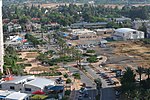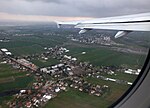Sabena Flight 571
1970s in Tel Aviv1970s murders in Israel1972 crimes in Israel1972 in Belgium1972 murders in Asia ... and 19 more
AC with 0 elementsAccidents and incidents involving the Boeing 707Aircraft hijackingsAttacks on aircraft by Palestinian militant groupsAviation accidents and incidents in 1972Aviation accidents and incidents in IsraelCounterterrorism in IsraelHostage taking in IsraelMay 1972 events in AsiaMilitary operations of the Israeli–Palestinian conflictOperations involving Israeli special forcesPalestinian terrorismPalestinian terrorist incidents in EuropeSabena accidents and incidentsTerrorist incidents in Asia in 1972Terrorist incidents in Israel in the 1970sTerrorist incidents in Tel AvivVictims of the Black September OrganizationWikipedia extended-confirmed-protected pages

Sabena Flight 571 was a scheduled passenger flight from Brussels to Lod via Vienna operated by the Belgian national airline, Sabena. On 8 May 1972 a Boeing 707 passenger aircraft operating that service, captained by British pilot Reginald Levy, DFC, was hijacked by four members of the Black September Organization, a Palestinian terrorist group. Following their instructions, Captain Levy landed the plane at Lod Airport (later Ben Gurion International Airport). The hijackers demanded that Israel release Palestinian prisoners in exchange for the hostages. The standoff was ended by an Israeli commando raid in which all of the hijackers were killed or captured.
Excerpt from the Wikipedia article Sabena Flight 571 (License: CC BY-SA 3.0, Authors, Images).Sabena Flight 571
Circle Road,
Geographical coordinates (GPS) Address Nearby Places Show on map
Geographical coordinates (GPS)
| Latitude | Longitude |
|---|---|
| N 32.0094 ° | E 34.8769 ° |
Address
Circle Road
7015001
Center District, Israel
Open on Google Maps







